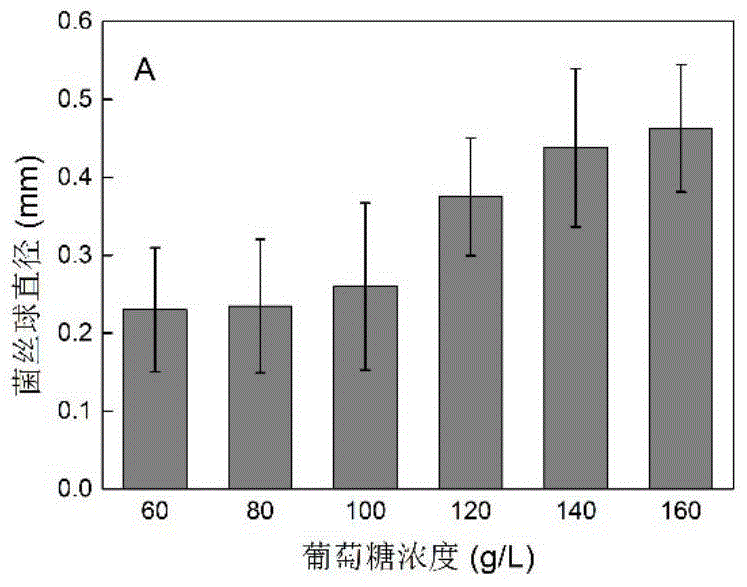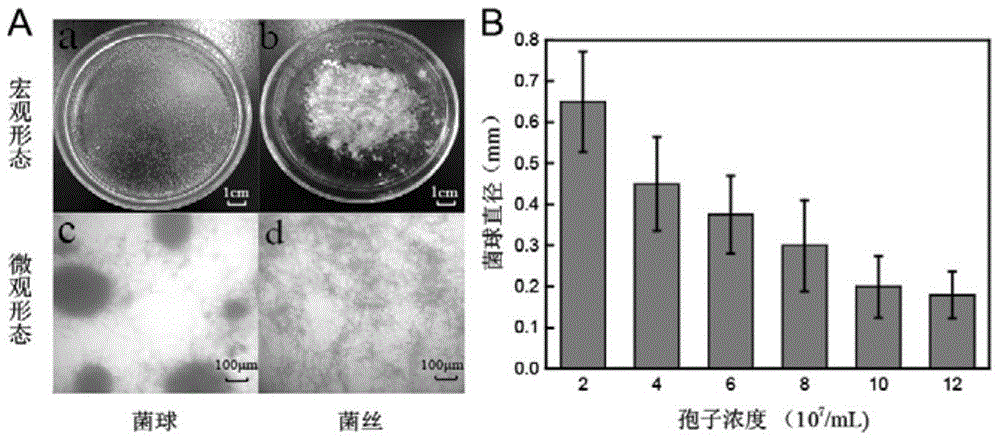Method for increasing kojic acid yield of Aspergillus oryzae
A technology of Aspergillus oryzae kojic acid and yield, applied in the field of fermentation engineering
- Summary
- Abstract
- Description
- Claims
- Application Information
AI Technical Summary
Problems solved by technology
Method used
Image
Examples
Embodiment 1
[0041] The influence of embodiment 1 glucose concentration on the diameter of bacterial ball
[0042] The spores in the sporulation medium were washed with sterile physiological saline to make a spore suspension, which was inoculated into seed medium containing different glucose concentrations (60-160g / L), and the size of the ball was measured after culturing for 30 hours. The result shows, along with the gradual increase of glucose concentration in the seed culture medium, A.oryzae bacterium ball diameter also increases to 0.463mm by 0.23mm thereupon (see figure 1 ).
Embodiment 2
[0043] The influence of embodiment 2 yeast extract concentration on bacterium ball diameter
[0044] The preparation of the spore suspension was the same as in Example 1, and then inoculated into the seed medium containing different yeast extract concentrations (2.5-15g / L), and measured the size of the ball after culturing for 30 hours at 30°C. The results showed that the effect of yeast extract on the size of A.oryzae spheroids was different from that of glucose. When the concentration of yeast extract increased from 2.5g / L to 10g / L, the diameter of A.oryzae spheroids decreased from 0.52mm to 0.265mm, Afterwards, as the concentration of yeast extract continued to increase, the diameter of the bacterium also increased (see figure 2 ).
Embodiment 3
[0045] The impact of embodiment 3 spore concentration on the formation of bacterial balls
[0046] Prepare different concentrations of spore suspensions and inoculate them into the seed medium of the same formulation, and measure the size of the spores after 30 hours of cultivation. The result is as figure 2 As shown, when the concentration of spore suspension is 10 7 ~10 8 When each / mL, A.oryzae mainly formed spheroids (see image 3 Aa / c), and within a certain range, the diameter of the spores was negatively correlated with the concentration of the spores, that is, the higher the concentration of the spore suspension, the smaller the diameter of the spores, and the concentration of the inoculated spores was 2×10 7 The diameter of bacteria balls / mL is the spore concentration of 1.2×10 8 3.61 times of each / mL (see image 3 B).
PUM
| Property | Measurement | Unit |
|---|---|---|
| diameter | aaaaa | aaaaa |
| diameter | aaaaa | aaaaa |
Abstract
Description
Claims
Application Information
 Login to View More
Login to View More - R&D
- Intellectual Property
- Life Sciences
- Materials
- Tech Scout
- Unparalleled Data Quality
- Higher Quality Content
- 60% Fewer Hallucinations
Browse by: Latest US Patents, China's latest patents, Technical Efficacy Thesaurus, Application Domain, Technology Topic, Popular Technical Reports.
© 2025 PatSnap. All rights reserved.Legal|Privacy policy|Modern Slavery Act Transparency Statement|Sitemap|About US| Contact US: help@patsnap.com



